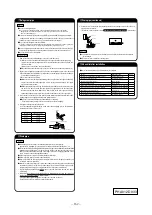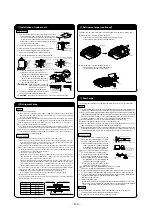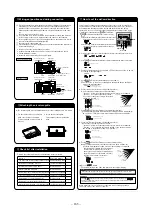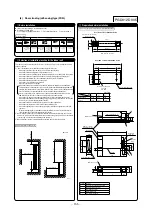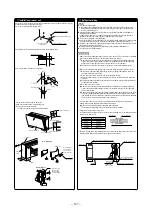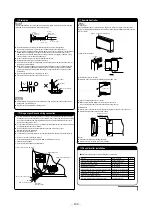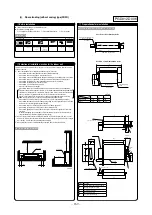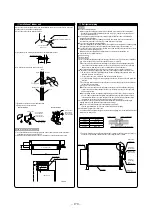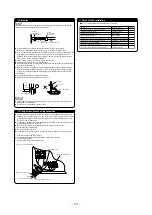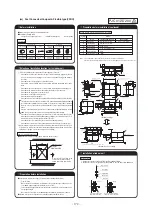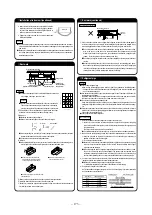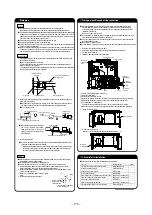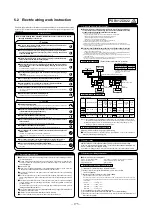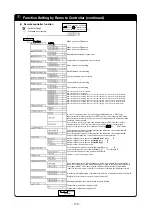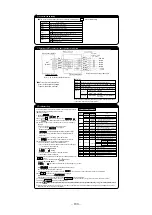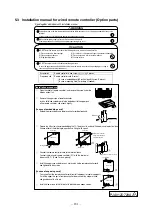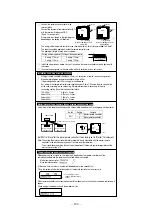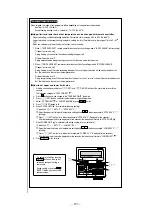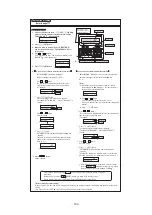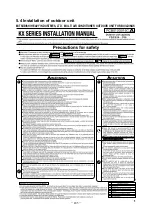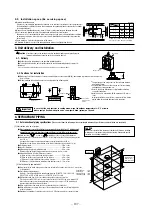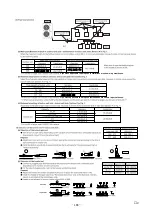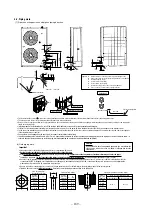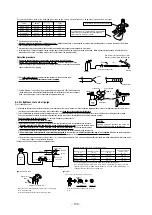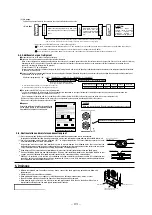
-
176
-
③
Remote Control, Wiring and functions (continued)
④
Trial operation (continued)
When indoor unit address number is displayed on
remote controller, pushing the (MODE)
button to make the indoor unit with that number
blow air (Display example:" ").
Push the (MODE) button again to stop the
operation.
However, this operation is invalid on the
air-conditioning running.
After a unit is energized, it is possible
to display an indoor unit address by
pressing button on
the remote control unit.
Press the or button to make
sure that all indoor units connected
are displayed in order.
ELECTRIC WIRING WORK INSTRUCTION
Ⓧ Ⓨ
Ⓧ Ⓨ
Ⓧ Ⓨ
Ⓐ Ⓑ
Ⓐ Ⓑ
Ⓧ Ⓨ
Ⓐ Ⓑ
Ⓐ Ⓑ
Ⓧ Ⓨ
Ⓐ Ⓑ
Ⓧ Ⓨ
Ⓐ Ⓑ
Ⓧ Ⓨ
Ⓐ Ⓑ
Ⓧ Ⓨ
Ⓐ Ⓑ
Ⓧ Ⓨ
Ⓧ Ⓨ
●
Install an over-current and earth leakage breaker (threshold current: 30mA) specified for
each unit without fail.
●
Provide a dedicated branching circuit and never share a branching circuit with other
equipment. If shared, disconnection at the circuit breaker may occur, which can cause
secondary damage.
●
Set earth of D-type.
●
Connection of a cable beyond 3.5 mm
2
is not permitted. When cables of over 5.5 mm
2
are
in use, provide a dedicated pull box to take a branch to an indoor unit.
●
Keep "remote controller line" and "power source line" away from each other on constructing
of unit outside.
●
Run the lines (power source, remote controller and "between indoor and outdoor unit")
upper ceiling through iron pipe or other tube protection to avoid the damage by mouse and
so on.
●
Do not add cord in the middle of line (of indoor power source, remote controller and signal)
route on outside of unit. If connecting point is flooded, it could cause problem as for electric
or communication.
(In the case that it is necessary to set connecting point on the signal line way, perform
thorough waterproof measurement.)
●
Do not connect the power source line [220V/240V/380V/415V] to signal side terminal block.
Otherwise, it could cause failure.
●
Screw the line to terminal block without any looseness, certainly.
●
Do not turn on the switch of power source, before all of line work is done.
●
Electrical wiring work must be performed by an electlician an qualified by a
local power provider. These wiring specifications are determined on the
assumption that the following instructions are observed:
①
Do not use cords other than copper ones.
Do not use any supply line lighter than one specified in parentheses for each type below.
-braided cord (code designation 60245 IEC 51), if allowed in the relevant part 2;
-ordinary tough rubber sheathed cord (code designation 60245 IEC 53);
-flat twin tinsel cord (code designation 60227 IEC 41);
-ordinary polyvinyl chloride sheathed cord (code designation 60227 IEC 53);
②
Provide a separate power outlet for each outdoor or indoor unit.
③
All indoor units grouped in one system must have power source that can be turned on or off simultaneously.
④
Pay extra attention so as not to confuse signal line and power source line connection, because an error in their
connection can be burn all the boards at once.
●
Connection of the line ("Between indoor and outdoor unit", Earth and Remote controller)
①
Remove lid of control box before connect the above lines, and connect the lines to terminal block according to
number pointed on label of terminal block.
In addition, pay enough attention to confirm the number to lines, because there is electrical polarity except earth line.
Furthermore, connect earth line to earth position of terminal block of power source.
②
Install earth leakage breaker on power source line. In addition, select the type of breaker for inverter circuit as
earth leakage breaker.
③
If the function of selected earth leakage breaker is only for earth-fault protection, hand switch (switch itself and type
"B" fuse) or circuit breaker is required in series with the earth leakage breaker.
Cabling system diagram
(Outdoor/indoor unit connection procedure)
Ⓐ Ⓑ
○
B
Ⓐ Ⓑ
Ⓧ Ⓨ
○
Y
Ⓛ
Ⓝ
Ⓧ Ⓨ
Ⓐ Ⓑ
Ⓧ Ⓨ
Ⓛ
Ⓝ
Ⓧ Ⓨ
Outdoor unit
Power source
Indoor unit1
Indoor unit2
Signal line (between indoor and outdoor units)
Use shielded cord for a signal line and connect “earth
(signal line)” at all the indoor units and
outdoor units.
Earth
Signal line
(between indoor unit)
Earth
Remote controller
Remote
controller line
Remote
controller line
Power source line specification
Note (1) The cord distances are calculated with a voltage drop of 2%. If the distance should exceed the
above data, review the cord thickness to use in accordance with your extension cord regulations.
(2) When total extension of remote controller line is more than 100m, change the size of cord
according to "
③
Remote Control, Wiring and functions".
In case of Heat recovery 3-pipe systems
Branching controller of heat recovery 3-pipe systems wiring
●
When this unit is used as a "Heat Recovery 3-pipe Systems", refer to the installation
manual of a branching controller (option).
Address setting is done by (1) Manual address setting or (2) Automatic address setting.
In the case of (2) "Automatic address setting", it is possible to change address setting by wired
remote controller after once complete setting.
As for details of setting procedure, refer to instructions attached to the outdoor unit for details.
Installation and wiring of remote controller
Control plural indoor units by a single remote controller
①
A remote controller can control plural indoor units (up to 16)
In above setting, all plural indoor units will operate under same mode and temperature setting.
②
Connect all indoor units with 2 core remote controller line for group control.
③
Use the function of manual address setting to set the indoor and outdoor address number.
○
Do not forget to set the number for the outdoor units.
④
As shown in the following figure, the remote control can be used to control multiple outdoor
units.
⑤
One remote control is able to perform group control for multiple units (maximum 16 units).
○
Use the rotary SW1 and SW2 provided on the indoor unit PCB (Printed circuit board) to set unique remote control
communication address avoiding duplication.
Outdoor unit
No.01
Outdoor unit
No.02
Indoor unit
Indoor unit
Outdoor No.01
Indoor No.01
Indoor unit
Indoor unit
Indoor unit
Indoor unit
Action time
Indoor unit
Action time
SW1” Master”
Action time
SW1” Slave”
Switch Setting Contents
Master
Slave
Slave remote
controller
Wired remote controller: SW1
Wireless kit: SW1-2
Master remote
controller
AIR CON NO
Confirming method of indoor units
Master/slave setting when more than one remote control unit are used
A maximum of two remote control units can be connected to one indoor unit (or one group of
indoor units.)
Latest "function setting" is superior than previous one.
Acceptable combination is "two (2) wired remote controllers", "one (1) wired remote controller
and one (1) wireless kit" or "two (2) wireless kits".
Set SW1 to "Slave" for the slave remote control unit. It was factory set to "Master" for shipment.
Note:The setting "Remote control unit sensor enabled" is only selectable with the master
remote control unit in the position where you want to check room temperature.
Checking operation data
Remote controller
Outdoor No.02
Indoor No.04
Outdoor No.01
Indoor No.02
Outdoor No.02
Indoor No.05
Outdoor No.01
Indoor No.03
Outdoor No.02
Indoor No.06
●
Be sure to have the electrical wiring work done by qualified electrical
installer, and use exclusive circuit.
Power source with insufficient capacity and improper work can cause electric shock and fire.
●
Use specified wire for electrical wiring, fasten the wiring to the terminal
securely, and hold the cable securely in order not to apply unexpected
stress on the terminal.
Loose connections or hold could result in abnormal heat generation or fire.
●
Arrange the electrical wires in the control box properly to prevent them from
rising. Fit the lid of the services panel property.
Improper fitting may cause abnormal heat and fire.
●
Make sure there is no dust or clogging on both the plug and the socket nor
loose connection of the socket before plugging, and plug in securely to the
end of the blade.
Accumulation of dust, clogging on the socket or plug, or loose installation of the socket could cause
electric shock and fire. Replace the socket if it is loose.
●
Use the genuine optional parts. And installation should be performed by a
specialist.
If you install the unit by yourself, it could cause water leakage, electric shock and fire.
●
Do not repair by yourself. And consult with the dealer about repair.
Improper repair may cause water leakage, electric shock or fire.
●
Consult the dealer or a specialist about removal of the air conditioner.
Improper installation may cause water leakage, electric shock or fire.
●
Turn off the power source during servicing or inspection work.
If the power is supplied during servicing or inspection work, it could cause electric shock and injury by
the operating fan.
●
Shut off the power before electrical wiring work.
It could cause electric shock, unit failure and improper running.
●
Perform earth wiring surely.
Do not connect the earth wiring to the gas pipe, water pipe, lightning rod and telephone earth wiring.
Improper earth could cause unit failure and electric shock due to a short circuit.
●
Make sure to install earth leakage breaker on power source line.
(countermeasure thing to high harmonics.)
Absence of breaker could cause electric shock.
●
Use the circuit breaker of correct capacity.
Using the incorrect capacity one could cause the system failure and fire.
●
Do not use any materials other than a fuse of correct capacity where a fuse
should be used.
Connecting the circuit by wire or copper wire could cause unit failure and fire.
●
Use power source line of correct capacity.
Using incorrect capacity one could cause electric leak, abnormal heat generation and fire.
●
Do not mingle solid cord and stranded cord on power source and signal side
terminal block.
In addition, do not mingle difference capacity solid or stranded cord.
Inappropriate cord setting could cause loosing screw on terminal block, bad electrical contact, smoke
and fire.
●
Do not turn off the power source immediately after stopping the operation.
Be sure to wait for more than 5 minutes. Otherwise it could cause water leakage or breakdown.
●
Do not control the operation with the circuit breaker.
It could cause fire or water leakage. In addition, the fan may start operation unexpectedly and it may
cause injury.
Security instructions
WARNING
CAUTION
①
Electrical Wiring Connection
②
Address setting
●
Do not install it on the following places.
(1) Place exposed to direct sunlight
(4) Hot surface or cold surface enough to generate condensation
(2) Places near heat devices
(5) Place exposed to oil mist or steam directly.
(3) High humidity places
(6) Uneven surface
③
Remote Control, Wiring and functions
①
Install remote controller referring to the attached manual.
②
Wiring of remote controller should use 0.3mm
2
x2 core wires or cables.
(on-site configuration)
③
Maximum prolongation of remote control wiring is 600 m.
If the prolongation is over 100m, change to the size below.
But, wiring in the remote controller case should be under 0.5mm
2
. Change the wire size outside of the case
according to wire connecting. Waterproof treatment is necessary at the wire connecting section. Be careful about
contact failure.
100-200m ..................... 0.5mm
2
×2 core
Under 300m ................ 0.75mm
2
× 2 core
Under 400m ................ 1.25mm
2
× 2 core
Under 500m ................ 2.0mm
2
× 2 core
④
Avoid using multi-core cables to prevent malfunction.
⑤
Keep remote controller line away from earth (frame or any metal of building).
⑥
Make sure to connect remote controller line to the remote controller and terminal block of
indoor unit. (No polarity)
④
Trial operation
The method of trial cooling operation
Remote controller line
(No polarity)
Remote controller line
(No polarity)
Electrical wiring work must be performed by an electrician qualified by a local power provider according
to the electrical installation technical standards and interior wiring regulations applicable to the
installation site.
●
Accord with following items. Otherwise, there will be the risks of electric shock and fire
caused by overheating or short circuit.
Operate the remote control unit as follows.
1. Starting a cooling test run.
①
Start the system by pressing the button.
②
Select “ (Cool)” with the (MODE) button.
③
Press the
TEST
button for 3 seconds or longer.
The screen display will switch to: “
”
④
When the (SET) button is pressed while “
” is indicated, a cooling test
run will start.
The screen display will switch to “ ”.
2. Ending a cooling test run.
Pressing the button, the (TEMP) button or (MODE) button will end a
cooling test run. (Cooling test run will end after 30 minutes pass.)
“ ” shown on the screen will go off.
A
Earth leakage breaker
Circuit breaker
Wiring specification
①
Electrical Wiring Connection (continued)
PSB012D922
Unit type Earth leakage breaker
Circuit breaker
Wiring size
Switch
breaker
Over-
current
protector
rated
capacity
Power
source
line
Wire
length
Signal line
Remote
controller
line
Earth
line
22-36
15A
30mA 0.1sec
30A
15A
2.0mm
2
×2
304m
0.75~
1.25mm
2
×2
0.3mm
2
×2cores
2.0mm
2
m
6
1
2
0
9
-
5
4
m
9
2
1
0
6
1
-
2
1
1
In case of Duct connected -High static pressure- type
71-140
15A
30mA 0.1sec
30A
15A
2.0mm
2
×2
87m
0.75~
1.25mm
2
×2
0.3mm
2
×2cores
2.0mm
2
m
8
4
0
8
2
,
4
2
2
Specification of each line
Power source line
Signal line (Shielded cord)
Remote controller line
2.0~3.5mm
2
0.75~1.25mm
2
0.3~2.0mm
2
Operation data can be checked with remote control unit operation.
1. Press the button.
The display change “ ”
2. Press the (SET) button while “ ” is displayed.
3.
When only one indoor unit is connected to remote controller, “ ” is displayed
(blinking indication during data loading).
Next, operation data of the indoor unit will be displayed. Skip to step 7.
4. When plural indoor units is connected, the smallest address number of indoor unit among all
connected indoor unit is displayed.
[Example]:
“ ” (blinking 1 seconds) “ ” blinking.
5. Select the indoor unit number you would like to have data displayed with the button.
6. Determine the indoor unit number with the (SET) button.
(The indoor unit number changes from blinking indication to continuous indication)
“ ” (The address of selected indoor unit is blinking for 2 seconds.)
“ ” (A blinking indication appears while data loaded.)
Next, the operation data of the indoor unit is indicated.
7. Upon operation of the button, the current operation data is displayed in order from
data number 01.
The items displayed are in the following table
.
※
Depending on models, the items that do not have corresponding data are not displayed.
8. To display the data of a different indoor unit, press the button, which allows you
to go back to the indoor unit selection screen.
9. Pressing the button will stop displaying data.
Pressing the (RESET) button during remote control unit operation will undo your last
operation and allow you to go back to the previous screen.
◎
If two (2) remote controllers are connected to one (1) inside unit, only the master controller is available
for trial operation and confirmation of operation data. (The slave remote controller is not available.)
Drain pump operation from remote control unit is possible. Operate a remote control unit by
following the steps described below.
1. To start a forced drain pump operation.
①
Press the TEST button for three seconds or longer.
The display will change “ ”
②
Press the button once and cause “ ” to be displayed.
③
When the (SET) button is pressed, a drain pump operation will start.
Display: “ ”
2. To cancel a drain pump operation.
①
If either (SET) or button is pressed, a forced drain pump operation will
stop. The air conditioning system will become OFF.
◎
If two (2) remote controllers are connected to one (1) inside unit, only the master controller is available
for trial operation and confirmation of operation data. (The slave remote controller is not available.)
Trail operation of drain pump
Number
01
02
03
04
05
06
07
08
09
10
11
12
21
22
23
24
25
26
27
28
29
34
35
36
37
38
39
Data Item
(Operation Mode)
(Set Temperature)
(Return Air Temperature)
(Remote Controller Thermistor Temperature)
(Indoor Unit Heat Exchanger Thermistor / U Bend)
(Indoor Unit Heat Exchanger Thermistor /Capillary)
(Indoor Unit Heat Exchanger Thermistor /Gas Header)
(Indoor Unit Fan Speed)
(Frequency Requirements)
(Response Frequency)
(Pulse of Indoor Unit Expansion Valve)
(Total Running Hours of The Indoor Unit)
(Outdoor Air Temperature)
(Outdoor Unit Heat Exchanger Thermistor)
(Outdoor Unit Heat Exchanger Thermistor)
(Compressor Frequency)
(High Pressure)
(Low Pressure)
(Discharge Pipe Temperature)
(Comp Bottom Temperature)
(Current)
(Outdoor Unit Fan Speed)
(63H1 On/Off)
(Defrost Control On/Off)
(Total Running Hours of The Compressor)
(Pulse of The Outdoor Unit Expansion Valve EEVC)
(Pulse of The Outdoor Unit Expansion Valve EEVH)
*
Summary of Contents for 112KXE6
Page 105: ... 101 Model FDC335KXE6 A PCB003Z035 shows local wining ...
Page 134: ... 130 PJF012D003 ...
Page 135: ... 131 ...
Page 139: ... 135 PJA012D751 b ...
Page 140: ... 136 ...
Page 206: ... 202 2 model type DIS model type HEAD ...
Page 207: ... 203 2 2 ...
Page 208: ... 204 2 2 2 2 2 ...

